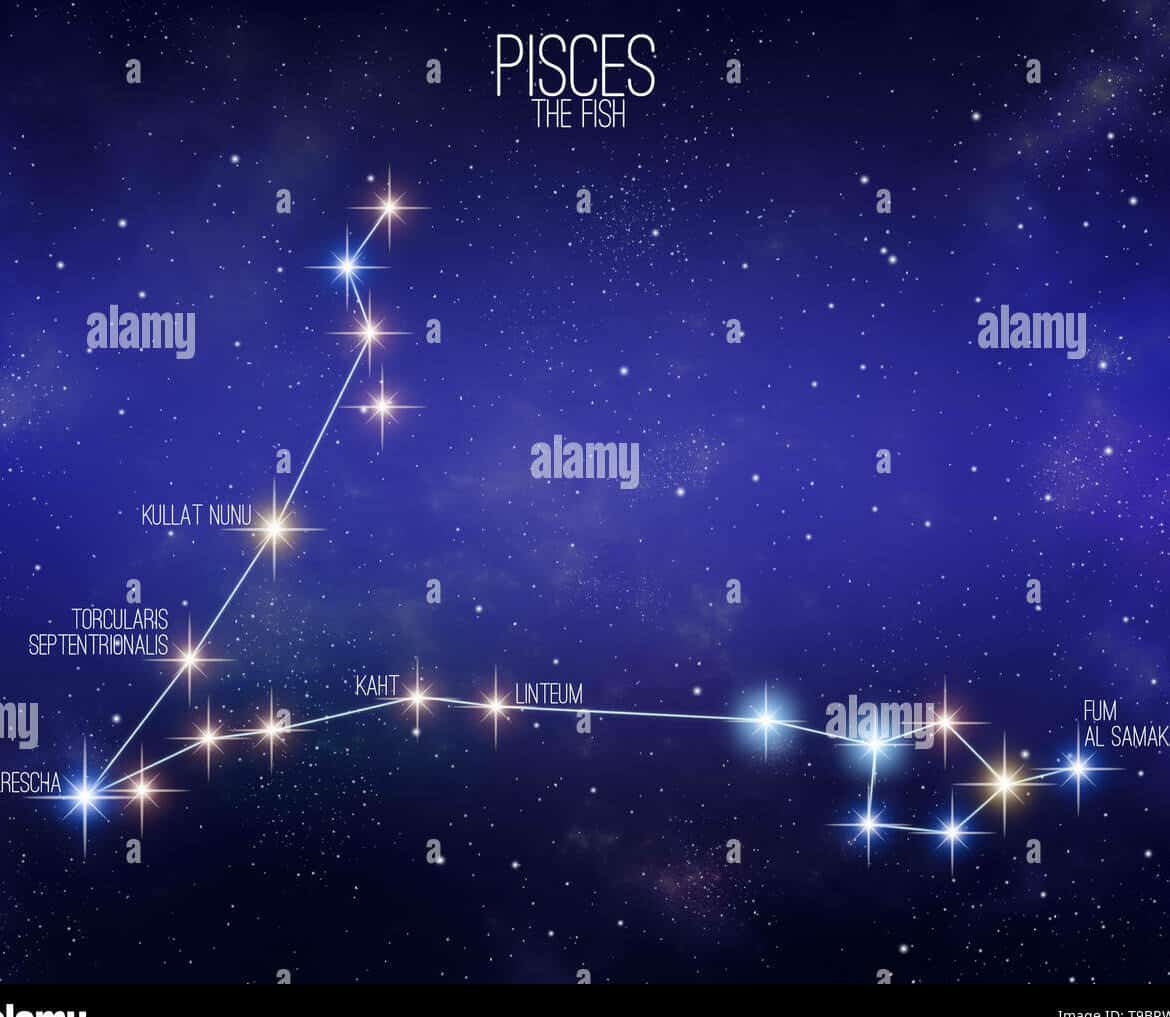Estimated reading time: 9 minutes
Share the article

- Natal Astrology
- Relationship Astrology
- Self Development and Psychology
- Predictive Astrology
- Horoscopes and Predictions
- Talismans
- Soul Formula
- Numerology
- Astrological Tarot
- World Astrology
- For beginners
- For professionals
- Development of an Astrologer
Read 9 min
What is this article about? The constellation Pisces is primarily situated in the Northern Hemisphere sky, and although it is not particularly bright, it contains several fascinating celestial objects. Another unique aspect of Pisces is that it is one of the zodiac constellations.
What makes Pisces unique? In the fields of astrology and astronomy, Pisces is viewed in distinct ways: the duration of the zodiac sign does not align with the dates when the Sun moves through the Pisces constellation. This has been recognized since ancient times and is shrouded in mystery and folklore. In this article, we will delve into the true nature of Pisces and explore its fascinating aspects.
Astronomical characteristics of the Pisces constellation
During moonless and clear nights, a careful observer can spot 75 celestial objects belonging to the Pisces constellation (♓ Pisces) in the sky.
If you carefully examine the sky on moonless and clear nights, you will be able to observe 75 celestial objects that make up the Pisces constellation (♓ Pisces). Among these, three objects stand out, shining as brightly as stars of the fourth magnitude. By mentally connecting the brightest stars, we can trace the outline of the Pisces constellation.
The brightest star, Alpha Pisces, lies at the top of the constellation. One side of this star faces north and is completed by a faintly glowing triangle formed by three stars. The second side faces west and is flanked by a pentagon of brighter objects. Moving away from the top of this figure that faces west, we can spot the second brightest star, Beta Pisces.
The initial of the two “fish” indicates the direction of Andromeda, while the second points towards Pegasus. Within the constellation, there are two distinct clusters that can be easily observed, the Northern cluster consisting of three stars and the Western cluster consisting of seven stars.
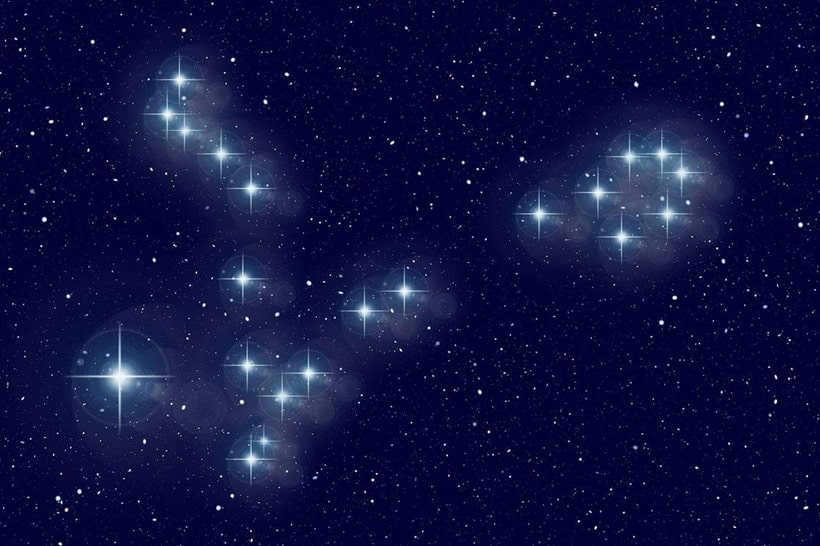
To envision the two fish connected by a ribbon in the constellation Pisces requires a vivid imagination, as depicted in ancient manuscripts.
Among the zodiacal constellations, Pisces occupies the fourth position in terms of angular area. In the entire sky, Pisces is ranked 14th and 7th in the Northern Hemisphere, following Volopassus. The celestial equator intersects this constellation near its southern border, and in the western sector, it crosses the ecliptic line at the point commonly known as the vernal equinox.
Since the majority of Pisces is situated in the corresponding half of the celestial sphere, it is classified as a northern constellation.
The Pisces constellation can be seen in the night sky almost everywhere on Earth. In Russia, there is a chance to observe it in September and October, although it may be difficult to spot due to its dim appearance. However, this cluster of stars contains some intriguing objects.
In modern times, the Sun passes through the Pisces constellation from March 12 to April 18, spanning a duration of 37 days. This section of the ecliptic puts Pisces in the third and fourth positions alongside the Leo constellation.
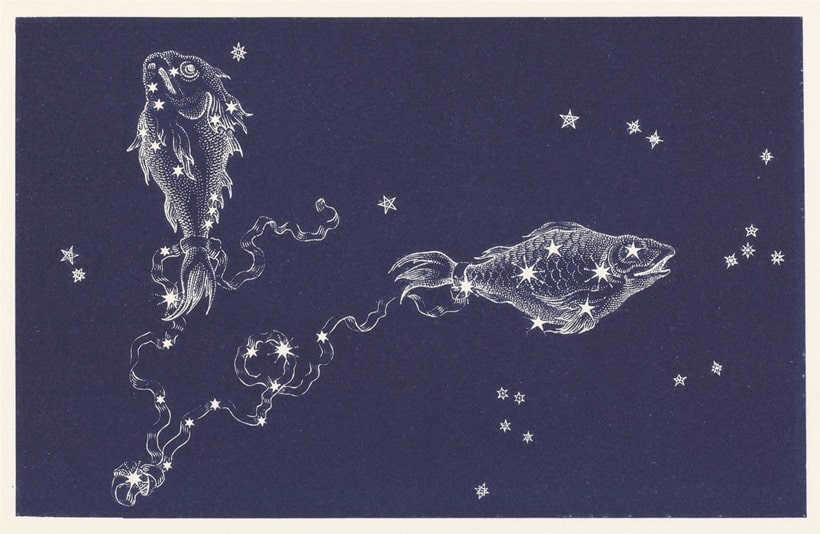

The definition of the first point of Aries was first established by the ancient Greek astronomer Hipparchus. He made this discovery after observing the Sun in the constellation Aries during the vernal equinox. However, the position of the Sun as it crosses the celestial equator is not fixed, but rather shifts along the ecliptic. This is due to the changing orientation of Earth’s axis of rotation in space, which occurs approximately every 73 years. As a result, the point of the vernal equinox moves approximately one degree over time.

In the Aquarius region, specifically in the zone designated by the International Astronomical Union as the Aquarius region, the vernal equinox point will be at 2,597.
The constellations closest to Pisces in the night sky include Aries, Triangle, Cetus, Pegasus, Aquarius, and Andromeda.
The Stars of the Pisces Constellation
That is why the vernal equinox point is currently situated in Pisces. Here, you can observe how once a year, the celestial body reaches this point in the sky, which signifies the start of longer daylight hours for the Northern Hemisphere and the gradual decrease of daylight hours for the Southern Hemisphere of the planet.
Let’s explore the most notable stars in the Pisces constellation:
- Piscium – This giant star, located 294 light-years away, shines with a luminosity 316 times brighter than our Sun. It holds the top position in the constellation and is classified as a fourth magnitude star. The light emitted by this class G giant has a blue tint. It is sometimes referred to as Cullatus Nunu or Alferg.
- Alrisha – Al Risha, which means “rope” in Arabic, is the star that connects the western and northern parts of the constellation. It is the third brightest star in Pisces. This double star, also known as Alpha Pisces, consists of a pair of white dwarfs and serves as the starting point of the constellation.
- Omega Pisces – This celestial object within Pisces is located 106 light-years away from Earth and is composed of two dwarf stars.
Other celestial bodies in the constellation of Pisces:
- Gamma Pisces – stands out as the second most radiant star, a yellow giant positioned 130 light-years away from Earth.
- Iota Pisces – A yellow dwarf that is located at a slightly closer distance of approximately 45 light years.
- The carbon star TX Pisces – exhibits a relatively bright dark red luminosity.
- Beta Pisces – holds the distinction of being the most remote star within the constellation, situated approximately 492 light-years away. Arab astronomers have given it the moniker of the "fish mouth".
- Van Maanen’s star – boasts the closest proximity to our planet, being a mere 14 light years away. It was named in tribute to the Dutch astronomer who first discovered it. This celestial object resides along the western ray of the Pisces constellation and is one of the nearest dwarf stars to the Sun.

However, observing this constellation closely is just as challenging as spotting an actual fish in a body of water. Even the brightest star, Alphargus, has a modest magnitude of only fourth.
Other celestial objects within the Pisces constellation
Based on astronomers’ observations, over the past decade, two supernovae stars have been detected in the spiral galaxy Messier 74. The active formation of new objects is not the only characteristic of this star cluster. Recent calculations suggest the presence of a black hole, which emits extremely powerful radiation in the X-ray spectrum.

Furthermore, Pisces contains a celestial object classified as a lenticular SO type, known as the spiral galaxy NGC 524. Another galaxy in this category, NGC 488, possesses a relatively small size and low luminosity. However, it boasts a dense core, allowing for its observation through optical devices, albeit appearing as a blurry spot.
NGC 660 is a captivating spiral ring galaxy. It stands out due to the presence of two stellar disks that rotate at different angles to each other.
In close proximity to the Andromeda Nebula, there exists a cluster of galaxies. Within this cluster, scientists have identified eight star clusters, which are barely visible from Earth. These clusters were discovered independently during various years.
Additionally, it is important to mention the binary star system ζ Psc. It is composed of a large star and a star in the Main Sequence.
Locating the Pisces constellation in the night sky
To locate the Pisces constellation, one should observe neighboring star clusters such as Andromeda and Pegasus.
To locate the Pisces constellation, one should observe neighboring star clusters such as Andromeda and Pegasus. These groups of stars form a square shape with a chain of celestial bodies moving towards the northwest, often compared to a hand covering Pisces. Alternatively, one can follow the right foot of Perseus, which is visible from anywhere and points towards Aries and the Pisces constellation located behind it.

When searching for the Pisces constellation in the night sky, one can observe it at the approximate middle point between Aquarius and Aries. By closely examining this area, one can identify a geometric shape consisting of two straight line segments diverging at an acute angle. As we have already learned, the northern segment connects to a triangle, while the western segment leads to a pentagon. Within the Pisces constellation, there is a specific point known as the vernal equinox, which is where the Sun passes from March 12 to April 18.
The Legend and Historical Significance of the Pisces Constellation
The constellation of Pisces and its celestial neighbors have long been steeped in myth and history. One popular legend tells the story of two fish that emerged as a result of a deluge of rain that followed the ecliptic path. However, the tale fails to explain the significance of the ribbon that connects them.
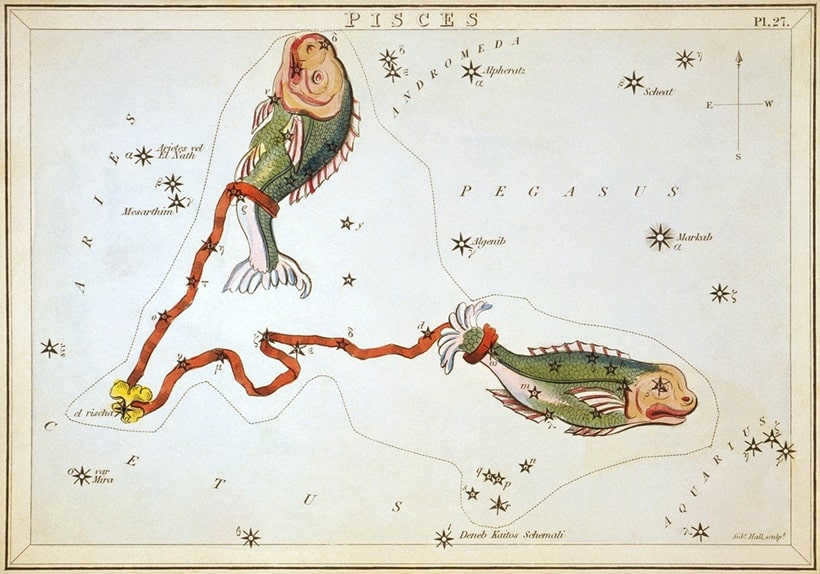
The ancient legends of the Phoenicians and Babylonian clay cylinders with cuneiform texts bring us the tale of this constellation, although with notable variations from what we currently understand about the significance of these celestial entities and star clusters. The modern interpretation of Pisces constellation came to be in the enlightened ancient Greece, with the description of this constellation in its contemporary form being first included in Claudius Ptolemy’s “Almagest” catalog of stellar bodies.
Perhaps for humanity, these stars are associated with fish because autumn, when they are best observed in the night sky, is a season of continuous rain and moisture that saturate the earth.
The origin of the name itself can be traced back to ancient Babylon. In the eyes of this civilization, a small group of not particularly bright stars in the night sky was strongly linked to more than just two fish. The Babylonians saw these fish as connected by a ribbon.
The Sumerians believed that the constellation of Pisces represented the god Enki, whom they worshipped. The fish symbolized Oanesa, or fish-man, one of the various forms of the great deity. The Sumerian priests even wore special ceremonial robes that reflected the symbolism of this zodiac constellation.
In ancient Egypt, Horus and Isis were associated with the Pisces constellation. Even with the rise of Christianity and the replacement of old beliefs, the legends and signs connected to Pisces could not be erased from people’s collective memory.
The Greeks also observed their gods in the stars and linked them to various myths and legends. In a tale akin to the ancient Roman one, the goddess of beauty Aphrodite and her son Eros were believed to have transformed into two Pisces. This transformation was necessary for them to evade the fearsome dragon Typhon, whose hundred heads breathed fire.

There exists a version of this tale in which the Pisces aided the goddess and her son by concealing them beneath the water and guiding them to safety.
Another tale regarding this constellation recounts the story of how Cyclops, consumed by a mad love for the beautiful Galatea, was left blind. Caught off guard by the jealous giant, Galatea and her lover sought refuge from Cyclops within the depths of the sea, only to meet their tragic fate there.
Each of these legends typically revolves around themes of profound love or miraculous escapes from imminent danger that threaten their protagonists. The essence of these events has been immortalized in the celestial expanse.
Countless ancient beliefs and legends have transitioned into the realm of the new religion.
Furthermore, numerous myths and stories about celestial entities have emerged within the Christian faith. It is worth noting that Christians have strongly connected the Savior himself with fish. This association stems from the Jewish belief that the long-awaited messenger of God would be associated with fish.
The Talmud includes a mention of the Messiah, referred to directly as “Fish,” as foretold in an ancient prophecy. It is said that his birth will occur when Saturn and Jupiter align in this constellation.
The astrological significance of the Pisces constellation
In the field of astrology, Pisces holds a prominent position as the twelfth sign within the zodiac. Astrology relies on the zodiacal circle, a ring of constellations encircling the Earth, that aids in locating celestial objects within the vast expanse of space. Dating back to ancient times, this circle has been divided into twelve equal parts, each spanning thirty degrees. These segments align with specific zodiac signs, which in turn correlate with the constellations residing within this celestial sphere.
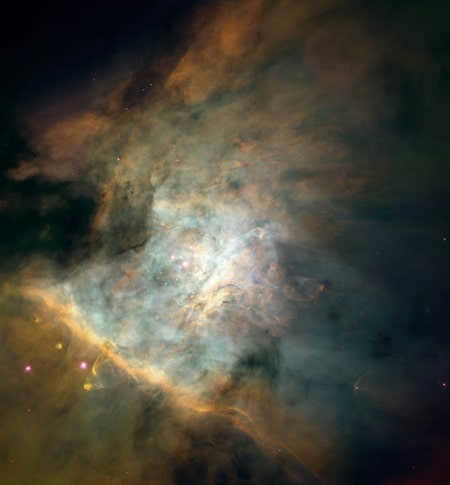
Do not confuse the zodiac sign Pisces with the constellation Pisces. In the field of Western astrology, the Sun’s movement through this particular section of the zodiac occurs from February 20 to March 20. The zodiac sign is taken into consideration when constructing a birth chart. In terms of its astronomical position, as mentioned earlier, the Sun is in the constellation from March 12 to April 18.
When counting from the point that corresponds to the vernal equinox, its corresponding section of the ecliptic is situated between the 330th and 360th degrees. Pisces is a mutable water sign that is ruled by Neptune.
This particular constellation in the zodiac does not possess a prominent luminosity in the nocturnal firmament, and individuals who are born under this astrological sign tend to lead more reserved lifestyles. They are known for their inherent affability and effortless ability to communicate. However, these positive characteristics can coexist with a proclivity for capriciousness and a certain degree of introspection.
Similar to other water signs, Pisces are replete with delicate emotions and have a predisposition towards mysticism. In other words, they are not entirely grounded in the reality of this world. Their inclination towards daydreaming and vivid imagination renders them susceptible to emotional influence from others.
Completing the cycle of the zodiac, Pisces encapsulate many of the qualities that the remaining eleven signs lack. While this may benefit them personally, it can also be a source of pain – as these traits are not necessarily advantageous for others.
Pisces is fortunate to have the support of three planets, keeping unnecessary worries at bay:
Neptune
Neptune, the ruler of the sea, represents the epitome of harmony that all individuals aspire to. Its influence instills a sense of idealism and dreaminess in those born under the Pisces sign. However, their inclination towards the inner world and attachment to the past sometimes hinders their ability to fully embrace the present and actualize their potential.
Jupiter
Individuals born under the sign of Jupiter possess a natural inclination towards kindness, tolerance, and empathy. They have a unique ability to persuade and convince others. Jupiter, being a fiery planet, brings a sense of comfort to individuals with water signs. For Pisces, in particular, this celestial patron bestows immense power and influence.
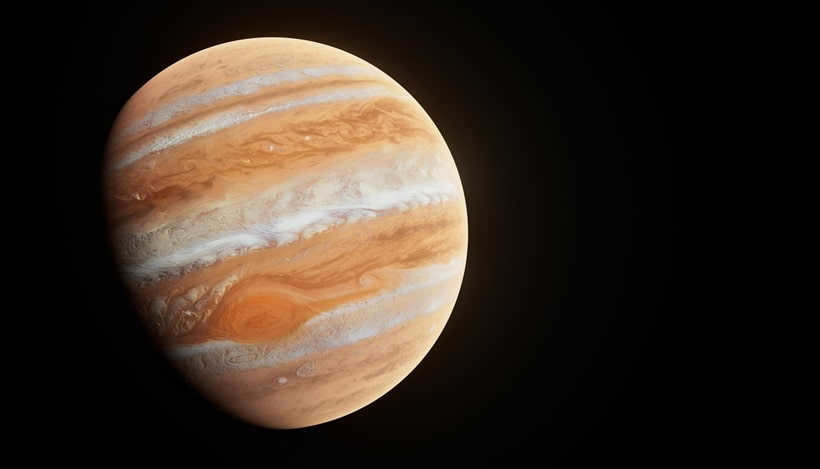
Venus in its highest position
The influence of Venus in its highest position grants Pisces an inherent empathy for the world that surrounds them.
The impact of Venus in its highest position grants Pisces an inherent empathy for everything that the world around them is brimming with. Not always knowing how to fully utilize this ability, individuals with this zodiac sign always, at a subconscious level, believe in love governing the world. For Pisces, this is as crucial as it is for no other representative of the zodiac. Love always comes unexpectedly for these individuals.
People always take notice when a significant relationship begins and fear its demise with every fiber of their being. They are extremely afraid of causing harm to their partner and themselves, actively avoiding distressing experiences. The strength of the bond between two individuals can be further analyzed and explained through synastry.
It may sound strange, but the strength of people born under this sign lies in their weak connection with the harsh reality of the world. Pisces individuals wholeheartedly rush to help others, and they have an unwavering belief in the realization of their plans.
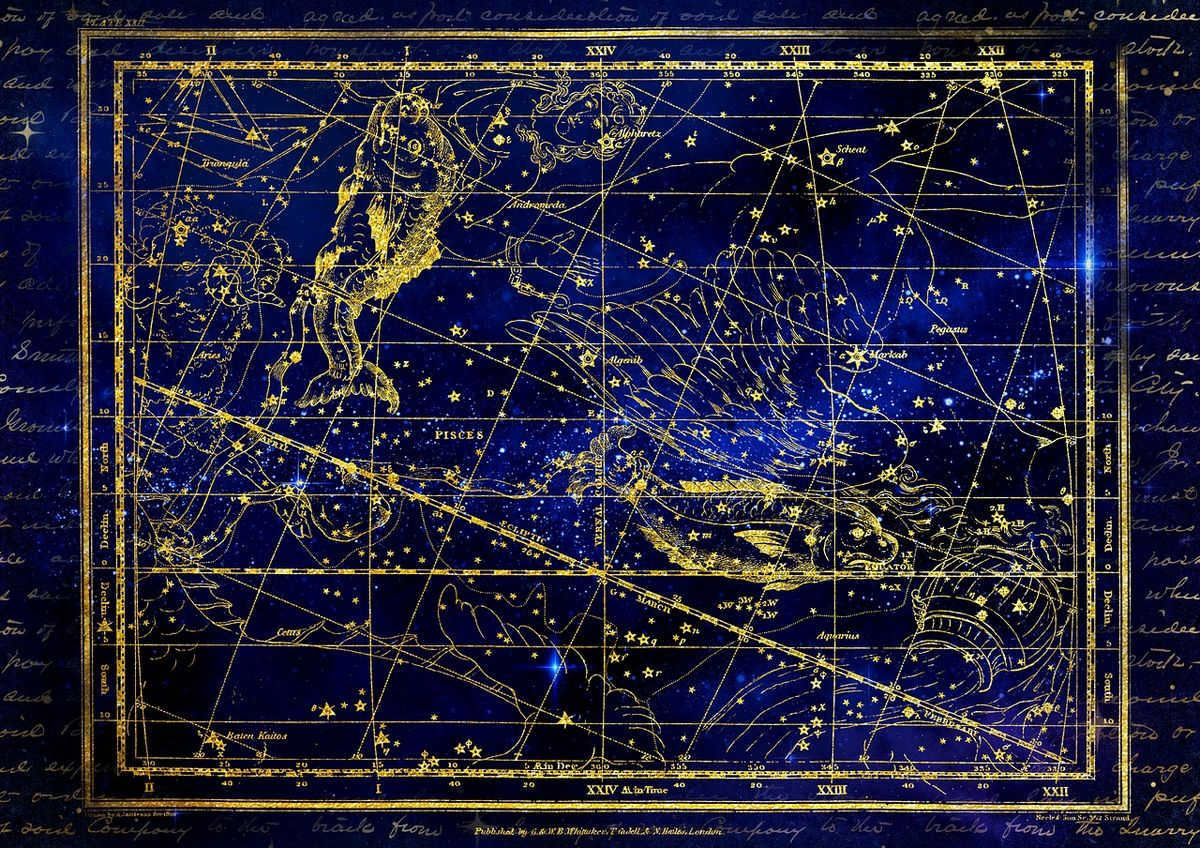
During the second century, Claudius Ptolemy, an astronomer who extensively studied the celestial realm, took notice of a cluster of stars in the eastern to western section of the sky. In the modern coordinate system, this cluster is identified as the first north square of NQ1. The ancient astronomer named this constellation “Pisces,” which translates to “fish,” and included it in the zodiacal group.
Observing this relatively large celestial entity is possible in latitudes ranging from +90 to -65 degrees, depending on the time of year and the observer’s location.
There are typically two asterisms that are distinguished within the constellation: the North Fish and the West Fish. The former is located near Andromeda, while the latter is situated between Pegasus and Aquarius.
Legends surrounding the origin of the constellation:
Pisces is an incredibly ancient star cluster. Images of it have been discovered in Egyptian pyramid tombs, as well as on clay tablets from Ancient Babylon. In the absence of modern knowledge, early humans believed that in the part of the sky where the constellations of Pisces, Capricorn, and Aquarius reside, there exists a sea of stars. When the Sun passes through this region of the sky, it causes rain to fall on Earth.
Interestingly, there is some truth to this belief: the rainy season in the Mediterranean coincides with the time when the Sun is in these Zodiac signs.
According to an ancient Greek myth, Gaia, the earth mother, once battled the Olympian gods for power and sent her monstrous offspring, Typhon, to confront them. Typhon was a fearsome dragon with a hundred heads that breathed fire from its eyes, making it the most terrifying creature to ever exist.
During this time, the goddess of love, Aphrodite, was taking a leisurely walk along the banks of a picturesque river with her son Eros. When Typhon suddenly emerged from the ground, they were filled with fear and fled. Luckily, the water came to their aid, allowing them to escape. As they fled, Aphrodite and Eros transformed into fish and hid at the river’s bottom. The river nymphs assisted them by tying a long rope between Aphrodite and Eros, preventing them from being carried away in different directions by the current. Unfortunately for Typhon, he was left with nothing.
As a token of their gratitude for their rescue, the gods immortalized Aphrodite and Eros by placing their images in the night sky, forming the constellation Pisces.
The legend of the divine fish tail
The Phoenician myth surrounding the creation of the constellation of fish tells a slightly different tale: during a time when the river was teeming with fish, a stunning woman with voluptuous curves and her young son arrived at its shores. This woman was none other than the Goddess of Fertility, Astarte, accompanied by her son.
Captivated by her beauty, she leaned over the water’s edge. Suddenly, a monstrous creature emerged from the shore, threatening their safety. In a desperate attempt to protect her son, Astarte swiftly tied him to herself and cast him into the river, transforming him into a small, colorful fish. She intended to do the same to herself, but her haste caused her body to only partially submerge in the water, leaving her with a fish tail as her only remnant of her former self.
To avoid suffocating underwater, she transported herself and her son to the twinkling night sky, where their image became permanently etched. As a reminder of her encounter with the monster, Astarte was left with a tail in place of her once beautiful legs.
What is the number of stars in the Pisces constellation?
The Pisces constellation is challenging to spot without the aid of a telescope. Those who are dreamers and romantics and gaze at the night sky can only appreciate its beauty on rare nights without a moon or clouds. This is because Pisces does not contain any particularly bright stars.
Astronomers have identified over 160 celestial bodies within the constellation, but only a handful of them possess significant stellar magnitude:
- Al Pherg, also known as Kullat Nunu, is a massive star that shines 300 times brighter than the Sun. However, it is situated nearly 295 light-years away, making it appear as a minuscule speck to us.
- Alpha Alrisha, which means “twine” in Arabic, marks the beginning of the Pisces constellation and consists of two white dwarf stars.
- Gamma Pisces, the second brightest celestial object within the constellation, is a yellow giant that remains visible in the night sky for most of the time.
- Pisces TX is a carbon-rich red star.
- Beta Pisces is the farthest luminary from our planet. Astronomers have associated it with the mouth of the fish.
- Iota Pisces is a yellow dwarf that was previously believed to be the closest star to us in this cluster. It is located approximately 45 light-years away.

Recently, researchers made a discovery that within the Pisces constellation, there is another star known as van Maanen. This particular star is located just 14 light years away and is a white dwarf situated in the western region of Pisces. However, despite its proximity, its radiance is nearly imperceptible from Earth.
Other celestial objects in the constellation
Aside from stars themselves, Pisces also contains:
- Several spiral galaxies, including Messier 74, NGC 524, NGC 528, and NGC 660;
- A cluster of galaxies near Andromeda, including NGC 375, 379, 380, and 383-386, 388 (although these objects have been identified by scientists, they have not yet been observed from Earth);
- The binary star system ζ Psc.
The Vernal Equinox point is located in Pisces (the Sun is in this zodiacal constellation from March 12 to April 18).
1- Among the constellations known to modern science, this constellation ranks as the 14th largest in the night sky.
2- Out of the 160 stars that compose Pisces, only 75 are visible through a telescope. To observe the remaining stars, more powerful optics are required.
3. In Russia, the faint glow of Pisces can be observed in the sky from September to November. However, during the period when the Sun enters this zodiacal sign (starting from March 11), the constellation cannot be seen.
4. An annual meteor shower takes place in the constellation of Pisces on September 19. The particles from Asteroid 2003 QC10 travel at a speed of 30 kilometers per second, creating a mesmerizing spectacle when observed from Earth.
5. Messier 74, the spiral galaxy mentioned above, is currently undergoing the process of nucleation and the creation of new stars. Scientists have observed the emergence of two new dwarf stars in the past decade alone. Additionally, this galaxy is home to a black hole.
Famous Individuals Born under the Pisces Zodiac Sign
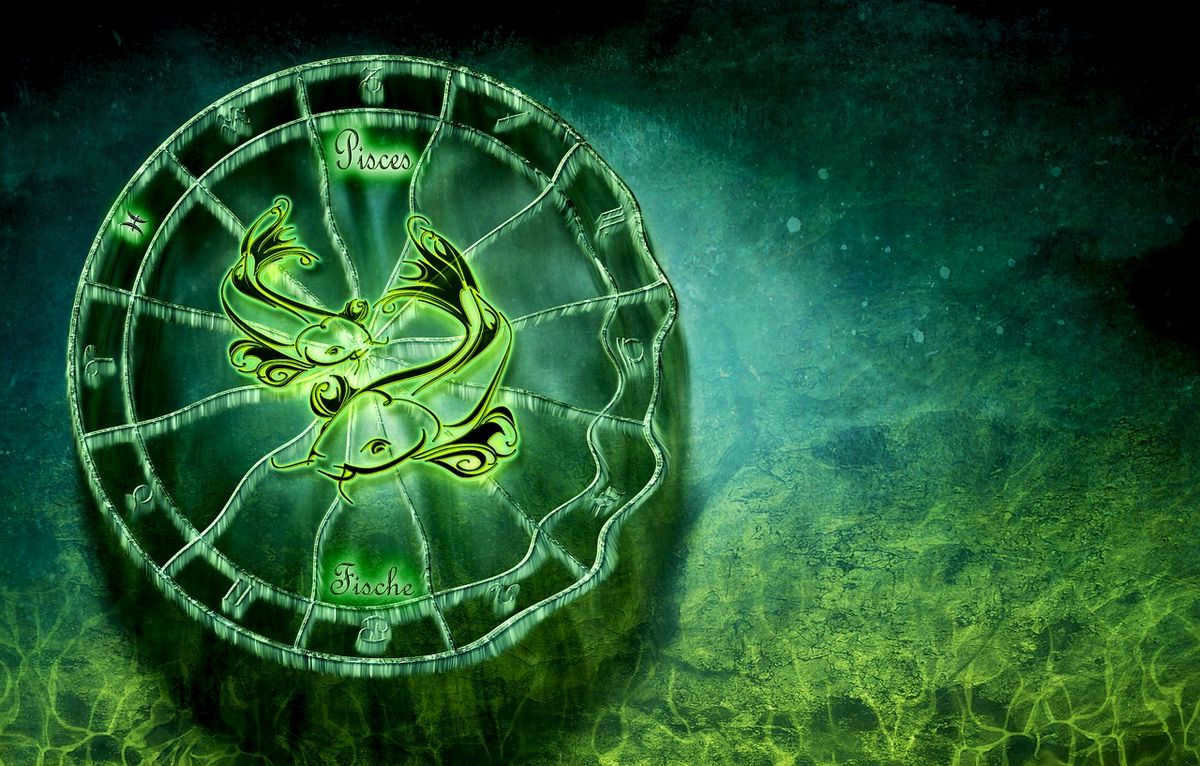
Astrologists claim that individuals born under this water sign possess a highly imaginative and easily inspired nature. They demonstrate great sensitivity to the mood and emotions of others, yet can also be quite unpredictable.
Among the representatives of this controversial sign, there are numerous renowned personalities:
- Hollywood actor and producer Bruce Willis (born on March 21, 1955);
- world-famous screenwriter and director Luc Besson (born on March 18, 1959);
- showman and Russian comedic actor Pavel Volya (born on March 14, 1979);
- entrepreneur, inventor, and chairman of the board of directors of Apple – Steve Jobs (born on February 24, 1955);
- theoretical physicist Albert Einstein (born on March 14, 1879);
- famous Russian TV presenter Nastya Ivleeva (born on March 8, 1991);
- Yuri Gagarin, a Soviet pilot, became the first person to walk in space on March 9, 1968;
- Justin Bieber, a Canadian musician, was born on March 1, 1994;
- Natalia Vodianova, a model, was born on February 28, 1982;
- Mikhail Gorbachev, a politician, was born on March 2, 1931;
- Sergei Burunov, a popular actor and impersonator, was born on March 6, 1977, among many other famous individuals.
Pisces is one of the constellations in the zodiac. It is positioned between Aries and Aquarius and is often divided into northern and western regions. The northern part is located under Andromeda, while the western part is situated between Pegasus and Aquarius. In reality, these are two separate groupings of stars. The western region of Pisces is known as the Crown according to Arab astronomers.
Interestingly, Pisces is a relatively large constellation in the night sky.
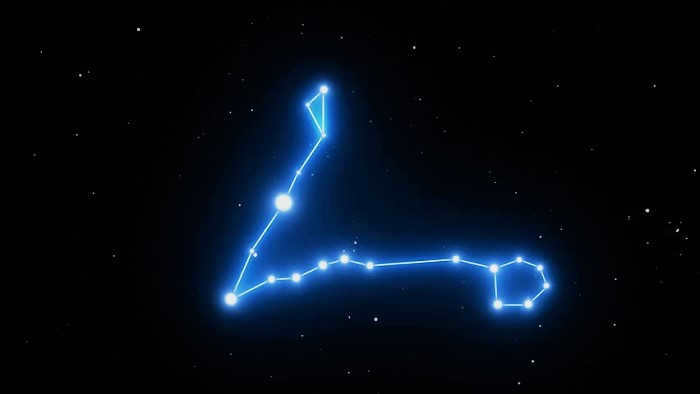
The Mythological Tale of the Pisces Constellation
Of course, what would a constellation be without a mythological story?
Throughout history, many cultures have associated the Pisces constellation with the goddess Aphrodite and her son Eros. According to legend, they transformed into fish in order to escape from the fearsome dragon Typhon.
Some believe that the fish in the water aided the goddess and her son in their escape, leading them to ascend to the heavens.

Nevertheless, there exists a tale surrounding the affection between Cyclops and the exquisite Galatea. As the legend goes, he caught sight of her in the company of another, and began to pursue them. In their attempts to evade him, the couple tragically drowned. However, their love did not sever them but rather united them in the celestial expanse.
Regardless, each narrative is imbued with love. Consequently, Pisces upon the astral sphere embodies and symbolizes this exquisite sentiment.
I must admit, I am uncertain as to why, but gazing upon the stars always evokes a desire to dream within me.
Vincent van Gogh
The main celebrities
Surprisingly, the constellation lacks the most brilliant superstar. Of course, it is home to dazzling luminaries, but they do not make the cut for the overall brightest list. Despite Pisces being home to over 160 stars, only a select few can be considered standouts.
Al Pherg (Kullat Nunu) holds the title of the first star in this area. It is a giant with a magnitude of four, and its light is over 300 times brighter than the Sun’s. However, its distance of 294 light years away from Earth makes it just another point in the starry sky for observers on our planet.
AlphaAlricia marks the beginning of Pisces. Interestingly, its name translates to “twine” or “rope.” It consists of two white twin dwarfs.
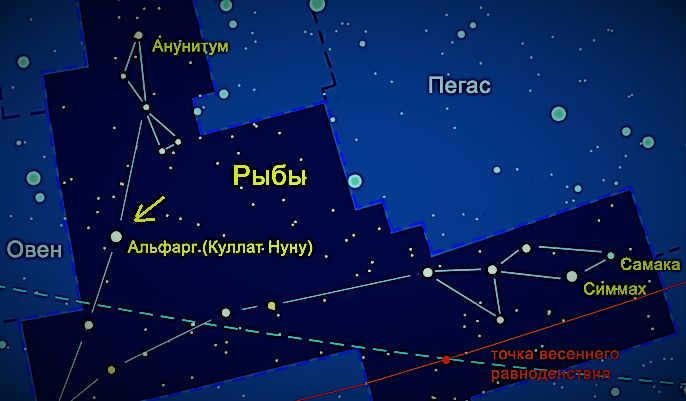

Adrian Van Maanen (March 31, 1884 – January 26, 1946) was a renowned astronomer from the Netherlands. In the year 1917, he made a groundbreaking discovery of a star that exhibited a significant proper motion. This star was later named after him, in recognition of his contribution to the field of astronomy.
Other celestial entities
Messier 74 (M 74) is a spiral galaxy that is currently experiencing active star formation. Recent scientific research has revealed that this galaxy has witnessed the birth of two supernovae stars in just the past decade. Furthermore, studies have also detected the presence of an extremely powerful X-ray emitting black hole within it.
Another notable spiral galaxy worth mentioning is NGC 524. It is classified as an SO-type galaxy, which means it falls into the category of lenticular objects.
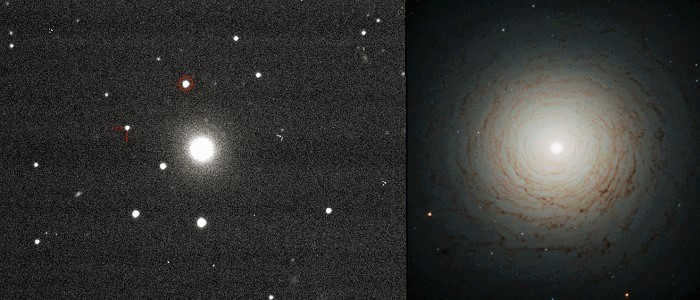
Stars demonstrate the vastness and splendor of the Universe, in which we, eternal explorers of space, strive to discover our own shining star.
Valentin Petrovich Rychkov
Observation
Incidentally, the constellation Pisces has renowned companions in the celestial expanse: Aries, Cetus, Pegasus, Andromeda, Aquarius, and Triangulum. Moreover, it is an ancient and highly acclaimed constellation. As the fascination with it persists, many individuals are curious about how to locate it in the starry firmament.
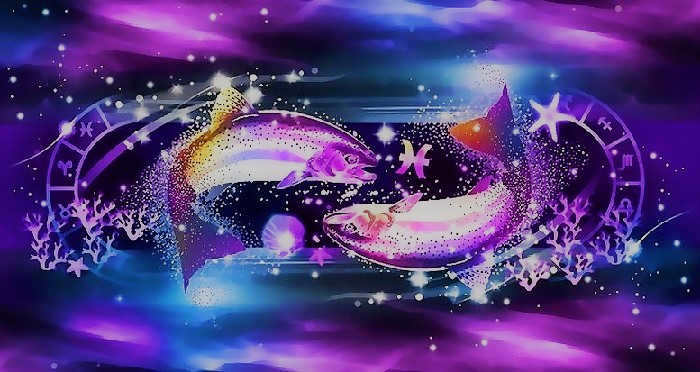
The universe is a vast and unimaginable entity to humans. However, the more we learn, the closer we come to understanding its cosmic existence.
While not particularly notable in the night sky, the constellation holds a significant place in the study of the universe. What may appear as an unremarkable patch of sky is actually incredibly captivating when observed closely. Additionally, the celestial objects that comprise the constellation are remarkably stunning.
Despite the difficulty in discerning the stars of Pisces for observers, there is still great interest in them. One could argue that the challenge of observing the constellation only adds to its intrigue. Perhaps this is partly why it remains popular.
 On September 19, 2015, I had the pleasure of witnessing the adorable antics of my beloved kitten. This delightful experience was shared by 61 people, with 12 of them leaving their affectionate comments.
On September 19, 2015, I had the pleasure of witnessing the adorable antics of my beloved kitten. This delightful experience was shared by 61 people, with 12 of them leaving their affectionate comments.  On November 2, 2015, President Putin was caught on camera wiping his hands. This intriguing moment caught the attention of 281 individuals, with 36 of them expressing their thoughts on the matter.
On November 2, 2015, President Putin was caught on camera wiping his hands. This intriguing moment caught the attention of 281 individuals, with 36 of them expressing their thoughts on the matter.
–Music
–News
–Photo Album
 We are expecting a baby 02:24 08.01.2012 Photos: 4
We are expecting a baby 02:24 08.01.2012 Photos: 4  New Year 2012 11:21 02.01.2012 Photos: 4
New Year 2012 11:21 02.01.2012 Photos: 4  Katya’s dolls -3 21:21 27.12.2011 Photos: 4
Katya’s dolls -3 21:21 27.12.2011 Photos: 4
–I work as a professional photographer
My collection of animal photographs
–Categories
- Faith, truth and good deeds (402)
- Crochet (1196)
- Accessories (80)
- Children (82)
- Home decor (259)
- Sweaters (326)
- Dresses (85)
- Patterns (172)
- Shawl hats (196)
- Skirts (1)
- Dives in hats (favorite series) (67)
- Design things (1177)
- Animations (105)
- Art (150)
- Houses and architecture (171)
- Couture (259)
- Postcards (97)
- Dividers (7)
- Frames (157)
- Computer Help (147)
- Schematics (86)
- From the present horror (189)
- From a past life (1055)
- War scary (324)
- In the decaying West (76)
- back in the USSR (122)
- A Beautiful Far Away (480)
- from SHOW MEN (225)
- Historical Portraits (678)
- KING stories (208)
- Beautiful places of the planet (613)
- Beauty in Gardens and Parks (128)
- Fortresses, Palaces and Castles (387)
- Ksyushka (13)
- My View. Cat and Dog (52)
- My view of Marilyn (8)
- My View. Angel-like (81)
- My look. Artists. (209)
- My View. Artistic (106)
- My View. Birthdays (historical) (49)
- My view. Historical and portrait (175)
- My View. History of clothing (68)
- My View. Puppetry (30)
- My View. Love (65)
- My View. Myths and Legends (115)
- My View. Unusual in the ordinary (166)
- My View. Very bookish (83)
- My Perspective. Authors (88)
- My Perspective. About Earth (331)
- My Perspective. Regal. (93)
- Moi vzglyad. Russian-Folk (284)
- My Perspective. Vintage Postcard (21)
- My point of view. Porcelain (12)
- My point of view. Artists (232)
- My perspective. Hat (25)
- MUSEUM-HERMITAGE (124)
- LEISURELY ACTIVITIES (2057)
- Movie night (265)
- home library (337)
- Picture Gallery (454)
- favorite music (950)
- Trips to interesting sites (55)
- RECIPES (280)
- health recipes (183)
- beauty recipes (95)
- recipes (food) (812)
- Seconds (141)
- baking (113)
- preparations (111)
- table (42)
- Breakfast (18)
- Beverages (43)
- Feast (24)
- salads and appetizers (165)
- Thirds (75)
- Costume Jewelry and Beads (112)
- Knitting with Needles (180)
- Needlework (198)
- Apartment Garden (13)
- I Engaged in Gardening (133)
- Creativity of the World’s Peoples (230)
- Ingenuity and Utility (105)
- My and My Daughter’s Efforts (18)
- My Daughter’s Paintings (10)
- My Knitting (6)
- Dancing, Dancing, Dancing! (163)
- Hobbies (2358)
- Candy Babies (409)
- For the Soul (535)
- Pets (348)
- Dolls (321)
- Cute Things (156)
- Vacation (4)
- Housewares (56)
- Vintage Postcards (444)
- Feng Shui and Stuff (88)
- Humor and Fun Stuff (678)
- Nudes (125)
- Vacation (81)
- Friday 13 (118)
- Laughter Therapy (210)
–Quotebook
Blue-blooded trade unionists and revolutionary satire After the October Revolution on the fronts of the Civil.
FASHION OF THE NEPA. Leather jackets, short hairstyles, gymnasthoraks The Civil War was over, and the population.
About the Harem. Part 4. From King Solomon to ancient Rome Edward Poynter .
About the Harem.Part 3.The Indian Maharajas The descendants of the “great lame” Tim .
About the Harem.Part 2.In Chinese Emperors The Chinese emperors had in.
–Explore using a diary
–Receive updates via email
–Connect with friends
–Engage with regular readers
–Join communities
–View statistics
Pisces, the final sign in the astrological Zodiac, brings the circle to a close.
Let’s begin our journey through the Zodiac signs from the end.
"Regarding Pisces, the stars in the head region of the southern fish are influenced by Mercury and, to some extent, Saturn; the stars on the body are influenced by Jupiter and Mercury; the stars on the tail and the southern part of the ligament are influenced by Saturn and, to some extent, Mercury. As for the northern fish, the stars on its body and backbone have a similar effect as Jupiter and, to some extent, Venus; the stars in the northern part of the conjunction have an influence similar to Saturn and Jupiter; and the bright star at the conjunction has an effect similar to Mars and, to some extent, Mercury. "
Claudius Ptolemy – On the Influence of the Stars – "A Mathematical Treatise in Four Parts"
The epigraph by Ptolemy regarding constellations is aptly demonstrated by a collage created using an image from Jan Hevelius’ atlas. It is likely that ancient and medieval astronomers were able to view the starry sky as a dynamic panorama of mythologies.
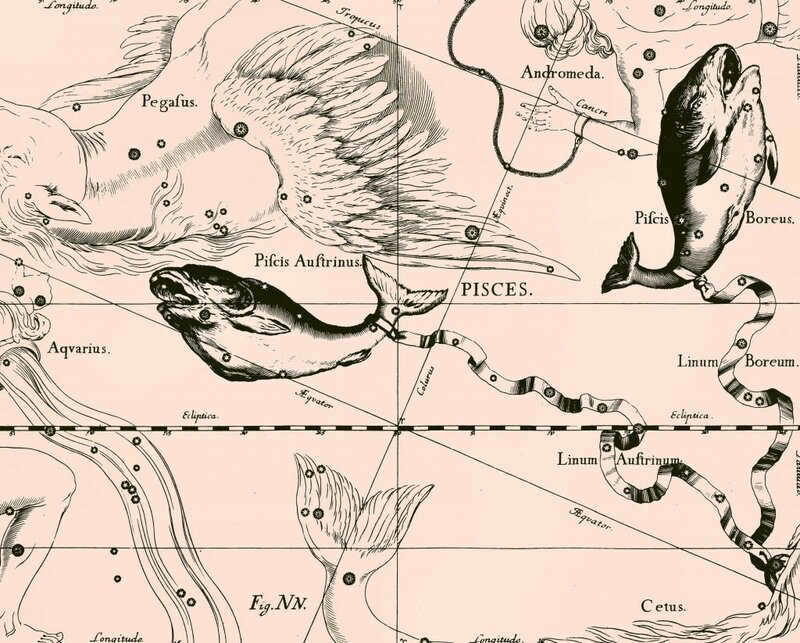
The zodiac constellation Pisces is widely known and consists of two distinct parts known as the Northern Fish and Western Fish. It is worth noting that the Western Fish is sometimes referred to by its alternative Arabic name, the Crown.
Within the vast expanse of the cosmos, there exists another group of stars bearing a similar name – the constellation South Fish, which is situated relatively close by. However, it is important not to conflate the two.
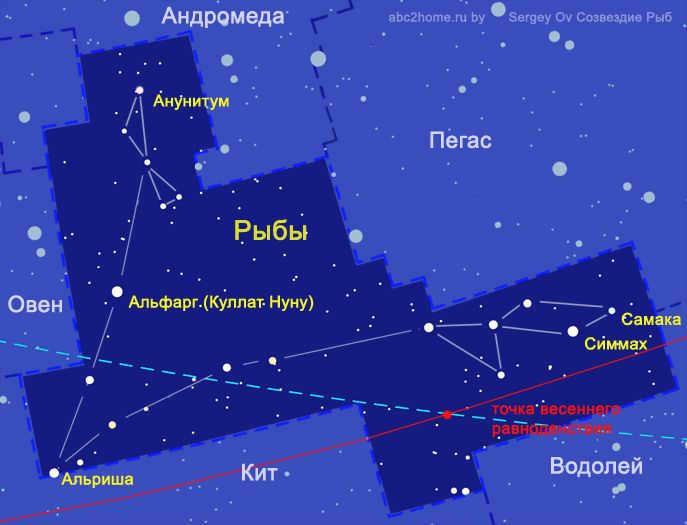
One should bear in mind that starfish are significantly bigger than their land-dwelling counterparts.
The celestial luminaries create a sharp angle, with the apex being the star α of Pisces. This star, which is the brightest one in the constellation shown in the image, has two names: Alfarg and Cullatus Nunu.
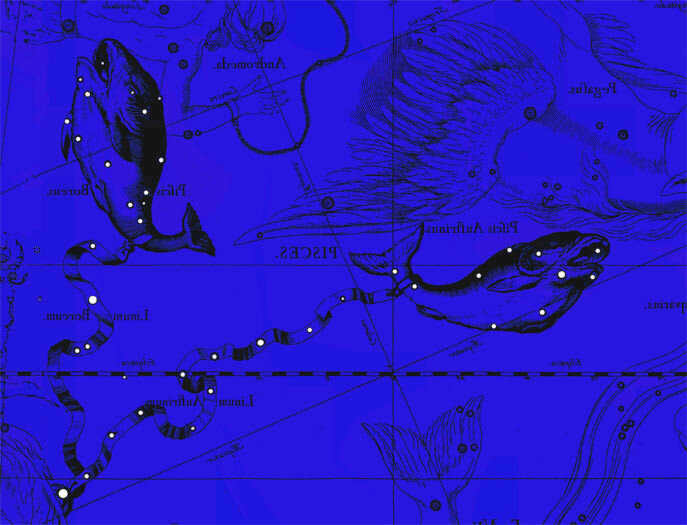
Based on an illustration in Jan Hevelius’s atlas, the Pisces constellation is a unique collage highlighting only the stars that were added by Hevelius himself. This constellation is composed of numerous stars, with 75 of them being visible to the naked eye.
Kullat Nunu is an ancient star that has been known by this name for over four thousand years, dating back to the time of the Sumerians.
One side of the angle points north, while the other extends westward. The rays of the star form a smaller triangle and a pentagon. Kullat Nunu translates to “rope for fish”, or kukan.
This indicates that the Sumerians, four millennia ago, saw the constellation of Pisces in the same way that we do today – as two fish connected by a celestial ribbon of stars.
According to Sumerian beliefs, Pisces is associated with the ancient god Enki, and represents Enki’s fish swimming on a kukan. Symbolically, it represents the abundance of fish in the Tigris and Euphrates rivers.
At the latitude of Babylon, Athens, and Alexandria, the zodiacal constellations pass close to the zenith, and the line of the ecliptic is nearly perpendicular to the horizon. The stars are so bright that it feels like you can reach out and touch them. On warm nights in the south, ancient thinkers were able to let their imagination run wild as they gazed at these constellations.
According to Greek mythology, Aphrodite and her son Eros (known as Venus and Cupid in Roman mythology) were strolling along the banks of a large river (possibly the Euphrates or the Nile).
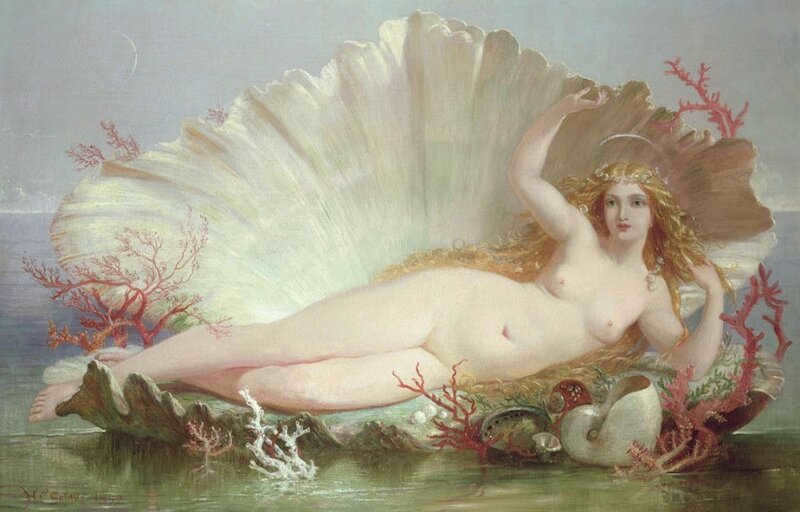
Aphrodite, painted by Cabanel Alexander

Venus and Cupid Musée du Louvre
Aphrodite admired the flowers while Eros practiced his archery skills. They were unknowingly observed by Tithon, an immortal demigod who was aging but still deeply in love with Aphrodite. Eros accidentally shot an arrow at the hidden old man, filling him with such intense love that he began to pursue Aphrodite and her son. They fled along the riverbank, desperately calling for assistance.
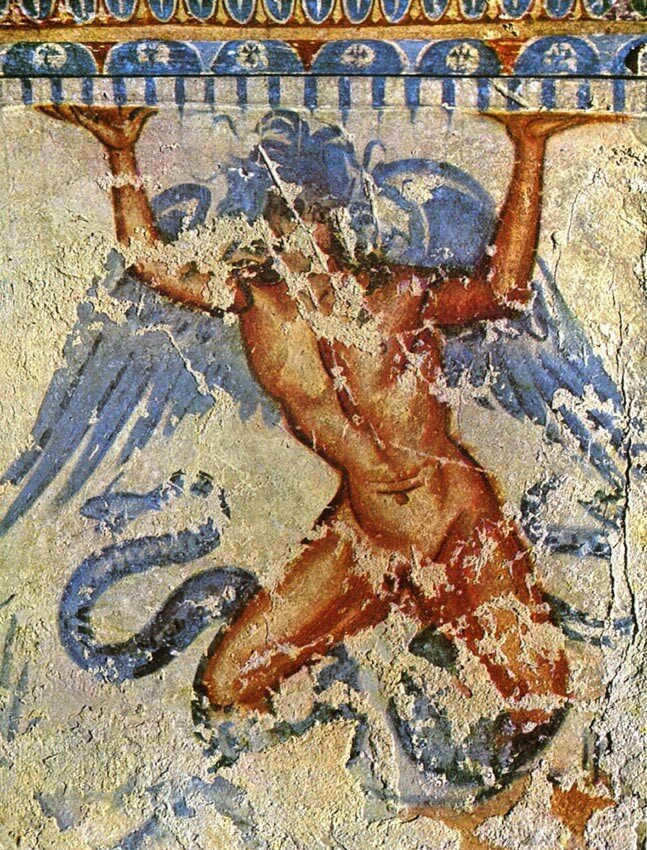
The massive Tithon, resembling a winding serpent.
And behold, a wondrous sight unfolded as two colossal aquatic creatures emerged and transported Aphrodite and Eros across the river. In gratitude, Aphrodite bestowed upon the Fishes her divine sash. Upon hearing this tale, Zeus decreed that the benevolent fish be immortalized among the stars in the celestial realm.
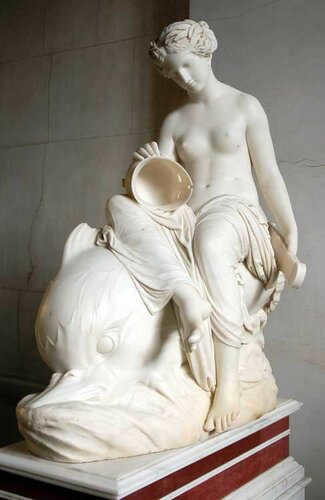
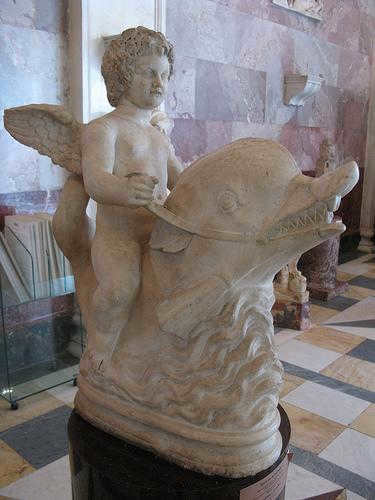
However, there exists another tale: Galatea and Akid were content in each other’s company, but their peaceful existence was overshadowed by the insatiable desire of the Cyclops Polyphemus. Upon laying eyes on the stunning Galatea by the shore, the monstrous creature relentlessly pursued her. It comes as no surprise that Polyphemus eventually spotted Akidas with Galatea, which filled him with fury and prompted him to chase after them with the clear intention of ending their lives. In a desperate attempt to escape, the unfortunate pair threw themselves into the ocean, only to meet their tragic demise by drowning. Witnessing this heart-wrenching event, the sorrowful gods transformed them into two celestial fish and brought them up to the heavens.

Paris France is the location of the stunning Polyphemus, Akid, and Galatea Fountain.
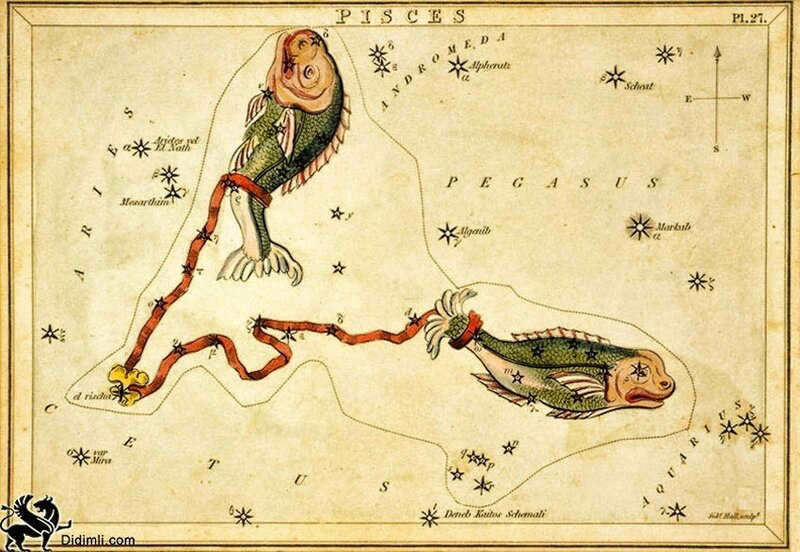
The constellation of Pisces can be seen in the atlas created by Jan Hevelius.
Based on information released by NASA, a planet has been detected within the Pisces constellation that is approximately two and a half times larger than Earth. Scientific calculations indicate that this planet is situated approximately 180 light years away from our planet.
This planet orbits a star that is colder and slightly smaller in size compared to our Sun. However, the possibility of life on this planet is immediately dismissed due to the extremely high temperatures on its surface. This planet was discovered by experts using the advanced Kepler telescope.
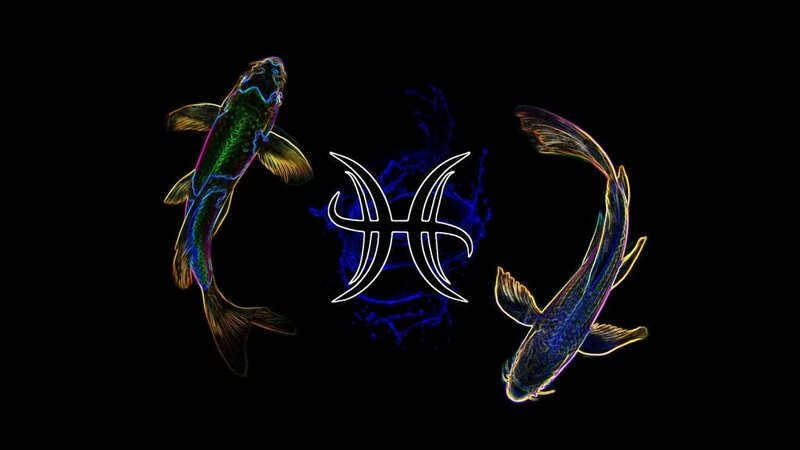
At present, the constellation of Pisces is crossed by the Sun for a period of 37 days, specifically from March 12 to April 18. This phenomenon occurs due to the Earth’s axis precession, causing the constellations to gradually shift in relation to the vernal equinox point. As a result, the Sun’s apparent movement through the constellations experiences a delay.
The Pisces zodiac sign corresponds to the period from February 19 to March 20.
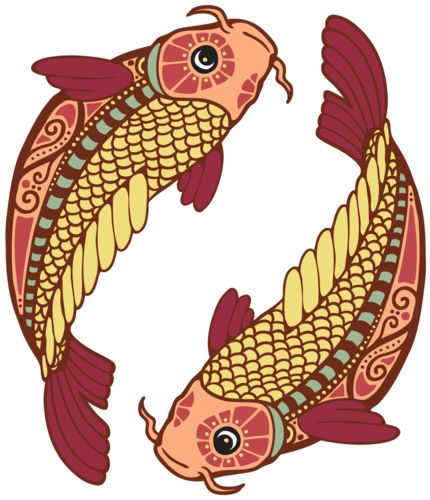
When it comes to astrology, Pisces symbolizes the element of water and represents the realm of dissolution. While Pisces is often associated with warmth, there are more challenges than meets the eye.
The zodiac symbol for Pisces depicts two fish swimming in opposite directions – one moving upwards towards spiritual growth, and the other descending into the depths of corruption and vice. Despite the potential for both highs and lows in their lifetime, Pisces individuals maintain a sense of wholeness and are not prone to internal conflicts.
Pisces encounters two primary challenges. The initial one is the selection of a spiritual journey: ascending or descending, and their differentiation, which is not evident for Pisces. The second challenge for Pisces is the issue of stability. Fluctuation is their destiny, that is how they navigate – swaying their tails, but the overall direction must be accurately determined and consistently sustained; regrettably, this is only achieved in the middle octave of Pisces and is upheld with significant difficulty; overall, it can be characterized as ranging from Manon Lescaut to the Virgin Mary.
For instance, beneath the constellation Pisces, we find the archetype of the bohemian – the impoverished artist who dedicates their entire existence to their craft, relying on the financial support of their lovers. Pisces individuals are highly inclined to dwell in the realm of their emotions and imagination, often perceiving it as more real than the external world. Consequently, the bridge between their inner and outer worlds is frequently too narrow. Pisces individuals possess a proclivity for indulging in wishful thinking,
And in general, they are the epitome of soulfulness, as the human soul is an unfathomable abyss that harbors an ineffable love for all things, including, naturally, themselves.
Renowned figures born under the sign of Pisces include Michelangelo, Victor Hugo, Enrico Caruso, Modest Mussorgsky, George Washington, Sergei Rachmaninoff, Nikolai Rimsky-Korsakov, and Marius Petipa.


